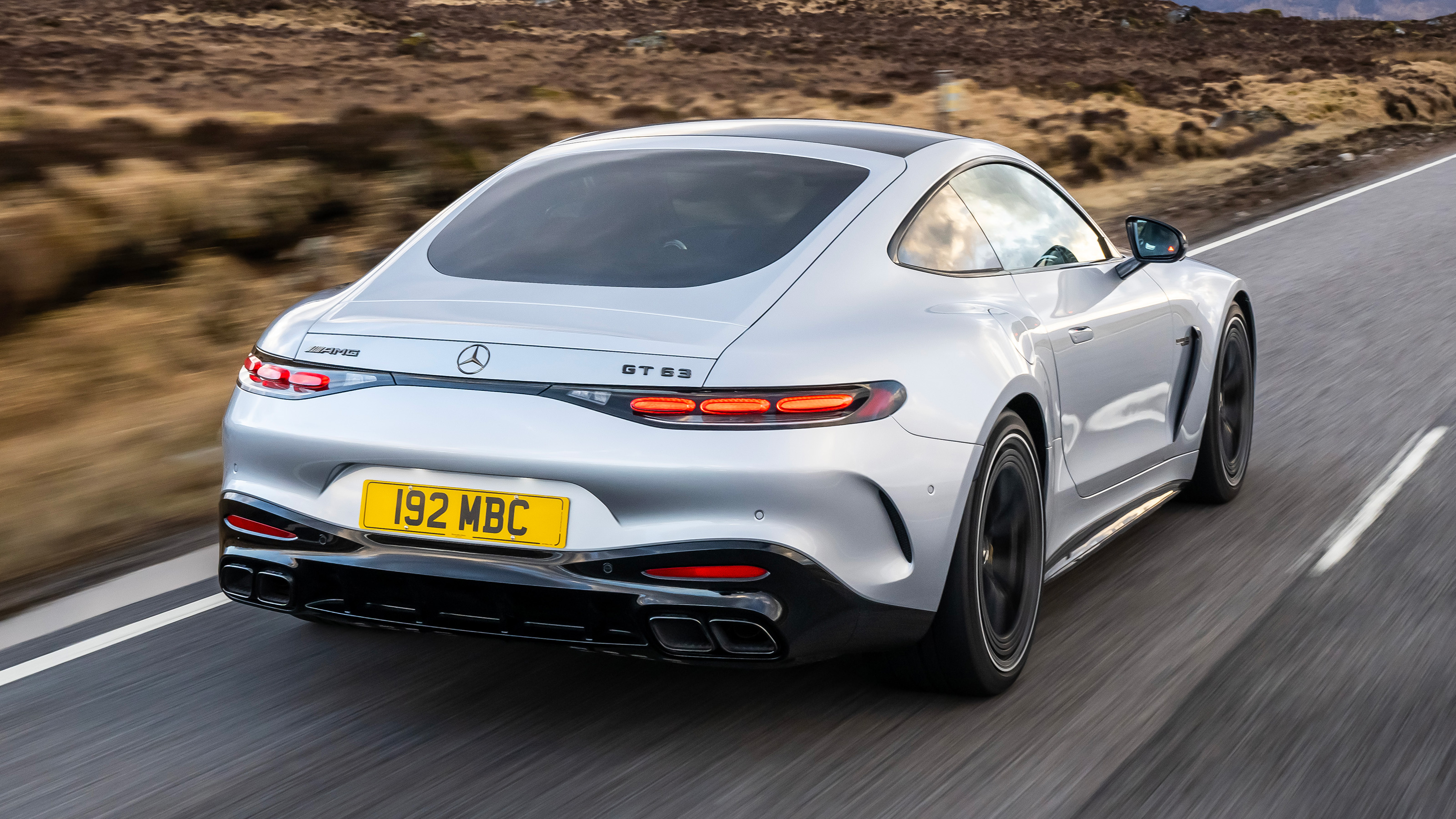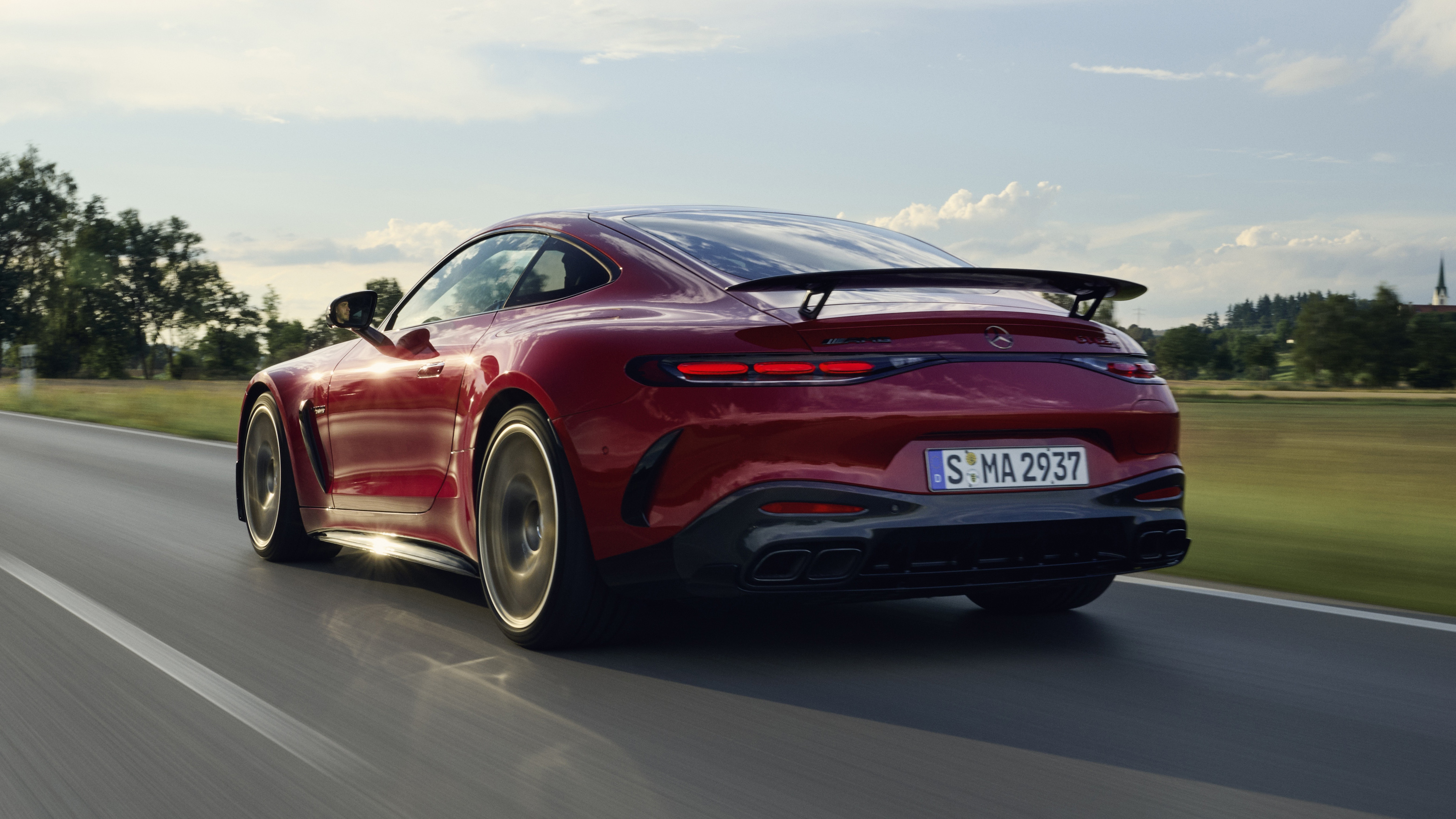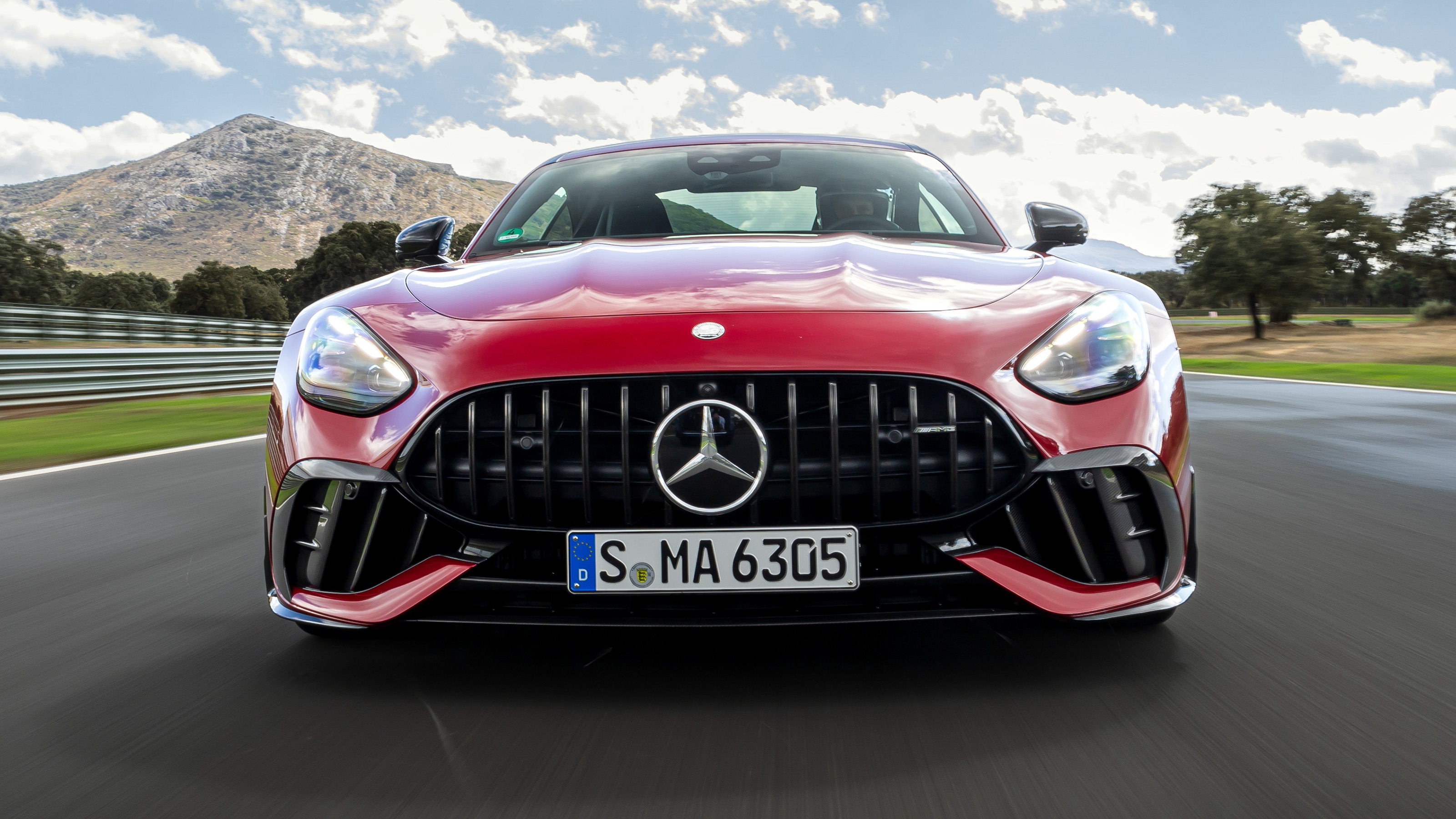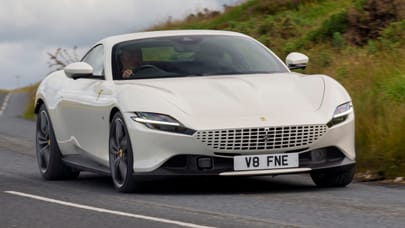
Good stuff
New found smoothness and practicality, composed road manners, cohesive styling, thumping V8 and hybrid powertrain
Bad stuff
Lost a little character in the process, can be harsh on UK roads when pushed, fiddly menus and screen graphics, cost
Overview
What is it?
The second generation of the AMG GT supercar – and no longer a supercar. The original arrived back in 2014 as an aggressive, long bonneted, two-seater. Now it’s an (optionally) four-seat Super GT, a rival to the Aston Martin DB12 and Ferrari Roma as much as the Porsche 911 Turbo.
Beyond the engine, very little is carried over from the first gen. The chassis architecture is all-new and shared with the SL, but Mercedes is at pains to point out this is not an SL with a fixed roof and that the two cars were developed independently. That’s clear when you start driving it. The GT is far more fluent and capable; not only than the SL, but also its aggressive and edgy predecessor.
Has it followed the C63 down the hybrid path?
The GT first arrived with AMG’s familiar 4.0-litre twin turbo V8 in two states of tune: a GT 55 with 469bhp and a GT 63 with 577bhp courtesy of higher turbo boost pressure, better airflow and modified engine software. Then came the GT 43, complete with the bonkers little 415bhp 2.0-litre turbocharged four-pot from the AMG A45 S.
However, Mercedes now sells the range-topping GT 63 S E Performance using the same plug-in hybrid tech as the 831bhp GT 63 4dr, but here hoofing out 805bhp and 1,047lb ft of torque. That power comes courtesy of the 4.0-litre twin turbo V8, an electric motor and a 6.1kWh battery, and the 0-62mph time of 2.8 seconds makes this the fastest accelerating Mercedes ever. Yeah, it’s quicker to 62mph than an AMG One.
You can plug it in too, but you’ll only get around eight miles of all-electric range. It recoups energy remarkably quickly though, so don’t worry too much about the single digit range. We've got more detail on what it's like to drive over here...
Oh, and you can already have a slightly more track-focused GT 63 Pro too. That gets an aero package as standard (scroll past the E Performance in the gallery below to see for yourself), extra cooling and a tad more power from the non-hybrid V8. That means 604bhp and 627lb ft of torque to help better demonstrate the focus beneath, bespoke-compound Cup 2R semi-slicks a cherry atop its sharper attitude.
How much do they all cost these days?
Prices kick off at a mite over £105,000, which might sound – by today’s standards – quite coddling for such a car, but bear in mind it’s the 4cyl GT 43. Purer for its rear-drive when everything else is 4Matic, but do you want a hot hatch engine in your super GT?
If you (understandably) crave a V8, then things begin at £142k for the GT 55 and its 469bhp, 3.9s performance. It’s another sizeable leap up to the GT 63, both in power and price. Its £164k tag gets you 577bhp and a 3.9s sprint yet the same fuel economy and CO2 as its lesser sibling, at least on paper.
Its harder-cored GT 63 Pro variant just dips under £180k, while the plug-in E Performance is £186k in its base trim but teeters close to £200k as the options pile on. Almost good value for over 800bhp, though, no?
Why has AMG repositioned the GT?
Due to customer demand. Buyers of the old car complained that it wasn’t usable enough, that it was cramped, difficult to see out of and they wanted more space. The message was clear: ‘We’re going to buy Porsche 911s unless you give us what we want’.
Only 5-10 per cent of AMG GT customers ever took their car on track, so that wasn’t a motivating factor. The Pro makeover is surprisingly subtle (at least compared to the old GT R Pro) until you learn a stat like that.
So how practical is it now?
The boot is downright generous: Merc says 321 litres, but it acts bigger. And those optional back seats fold, increasing load space to 675 litres. It’s almost a shooting brake. The rear seats are apparently fine for people ‘up to 1.5m’ tall. Translation: pre-teen kids with all the flexibility that entails. Oh, and remember that if practicality is your number one consideration, the hybrid battery hungrily chomps through the boot space. Nom nom.
It’s actually considerably bigger than the old car at 180mm longer and 70mm taller. It’s narrower than the last one though, due to customer feedback that they found it challenging to thread down narrow roads. They weren’t wrong about that. It’s a cleverly designed car – it doesn’t look larger than its predecessor, still has the thrusting front end, but the proportions and surfacing are good – it’s a handsome, striking car without being too overt.
It still has a relatively long bonnet, but the cabin isn’t so comedically far back now. The driver has been shunted forward by 200mm and there’s a larger glass area to improve visibility. There’s a catch to all this. The weight has gone up considerably. At two tonnes with fluids the GT weighs almost a quarter of a tonne more than the car it replaces. The hybrid is 2.2 tonnes. Just let that sink in…
I assume it’s stacked with tech, at least.
AMG is using plenty of it to help overcome the weight. It needed this new GT to have a broad sweep of capability and be easy to drive fast. The old car was snatchy at times, though got better as it was developed through the course of its life, but this one had to be right from the off. It needed to be smooth, yet agile... tricky with the size and weight.
Four-wheel steering is a logical, proven addition, but more radically the GT has done away with anti-roll bars. Instead, it features hydraulic cross-linked dampers – the same tech McLaren fits to the 750S. Pressure through the system not only varies suspension stiffness but can act very fast to resist roll through corners. It’s also optional on the SL, and will even be fitted to the G-Class in due course.
There’s also active aero via a five-position rear spoiler and drop-down underbody panel behind the front splitter, while the 4WD system deployed in all models above the 4cyl GT 43 can, as per other AMGs, be made rear-wheel drive only in Drift mode. There are six driving modes and an electronic differential on the rear axle. It’s a complex car, but to drive it’s friendly and benign, rides comfortably and quietly, yet has enough driving nous to entertain.
It’s rounded and fun, though on a very bumpy UK B-road the 63’s rear axle can manage to run out of vertical travel if you’re pressing on in one of the more committed modes. It’ll skip a little if you’re not careful. Use a slightly softer suspension setting if you live in the countryside: it’ll be ultimately faster and less airborne.
The E Performance is also remarkably compliant in its softer settings, but feels harsher as speed builds. It's seats are a bit firm too, so you don't want to be doing long distance in this one.
The Pro we’ve only sampled on track thus far, but it doesn’t alter the suspension setup so should prove as liveable as its siblings.
How does it stack up against rivals?
It’s up against a talented bunch. The McLaren GTS, Ferrari Roma and Porsche 911 Turbo are all stiffer and more sporting, this feels more aligned to the Aston Martin DB12 and Maserati GranTurismo even if it doesn’t have the same cachet. However, it’s considerably more desirable (if also more costly) than the £140,000 BMW M8.
Oh, and if you’re not so worried about sporting pretensions there’s the newly hybridised Bentley Continental GT in the same bracket.
What's the verdict?
It might seem like a subtle shift of positioning, to go from a relatively hardcore sports car to a Super GT – nothing more than the addition of practicality – but the new AMG GT comes across as a car more comfortable in its own skin. The old GT was always looking for a role, a purpose: now it has a clearer sense of its own identity.
It’s lost a little character and toughness in the process, but it’s well resolved and gets AMG back on track after the curiously imbalanced SL and poorly received 4cyl C63 hybrid. This is its flagship, its statement car: it keeps the roaring V8 alive a little longer and should attract more customers than the old GT.
It’s lost its uniqueness but gained a whole heap of capability and – with the 805bhp hybrid powertrain – a staggering turn of pace. That there are already five versions, a mere year into its life? A sign that this is AMG flexing its muscles and creating a car with almost as much breadth is that other 2+2 from Stuttgart.
The Rivals
Trending this week
- Car Review
Mazda 6e
- Long Term Review
How efficient is the hybrid Dacia Bigster?












